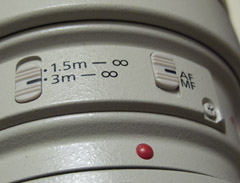 Sometimes autofocus can be really annoying: it’ll search and search for an object to focus on, and either never find it, or go through multiple cycles until it finally finds the right object to focus on. And by that time, you may have already missed the shot–especially if you’re photographing a quick moving subject like birds.
Sometimes autofocus can be really annoying: it’ll search and search for an object to focus on, and either never find it, or go through multiple cycles until it finally finds the right object to focus on. And by that time, you may have already missed the shot–especially if you’re photographing a quick moving subject like birds.
In previous posts, I’ve talked about a few ways you can get better control of your autofocus. But, there’s also a little switch on your lens that can help it focus faster.
The switch (pictured above on my Canon 300mm f/4L lens) basically tells the lens where you’ll be focusing: either on a near object or a far object. It limits the range of where your autofocus will search.
So, with the switch turned to 3m or beyond, my lens won’t try to focus on anything closer than 3 meters. This makes the autofocus work a lot faster when I know I’ll be focusing on something far (like wildlife). It’s a good idea to get in the habit of checking this switch before you get into “wildlife photography mode” 🙂
This little switch may not be available on all lenses (it really only makes sense on long telephotos), but check your lens and manual to be sure. I did a quick search for Nikon lenses and found out a similar switch is available on their longer lenses, it’s just called something different: focus limit switch (you can set it to “LIMIT” or “FULL” where the “LIMIT” setting will only try to focus on far objects).
If you enjoyed this article, and would like to read more, please signup for free updates by email or RSS.
 About the Author: Steve Berardi is a naturalist, photographer, computer scientist, and founder of PhotoNaturalist. You can usually find him hiking in the beautiful mountains and deserts of Southern California.
About the Author: Steve Berardi is a naturalist, photographer, computer scientist, and founder of PhotoNaturalist. You can usually find him hiking in the beautiful mountains and deserts of Southern California.
THANKS STEVE THIS WAS A BIG HELP FOR ME IN PHOGRAPHING LANDSCAPES.
I find this is useful when using my Tamron 90mm 2.8 Macro Lens. It has the full/limit switch on my Canon mount.
Wow, Steve, I had no idea this switch existed. I’m really hoping there’s one on my Sigma… one of my biggest frustrations is the lens deciding to focus on the twig in front of me rather than the bird further away…. thanks for the post!
@Amy – if the switch isn’t available on your Sigma lens, then you can also try manually turning the focus ring to a farther distance and then autofocus again. This helps sometimes too, cause if your lens’ focus ring is set at a somewhat close distance (something like 5 ft), then it’s more likely to autofocus on something that close.
Steve – I’ll try that since there was no switch! Thank you!
Hello Steve,
I truly enjoy all your articles.
Could you please tell me what to do when you take a pic and no matter what you do, the sky turns too white and cannot be changed even on photoshop?
Thank you, Gemma
@Gemma – Thanks for your kind words! The “white sky” problem is very common, and usually happens because the sky is so bright and everything else in the image is dark (your camera can’t handle that kind of range of brightness). One solution is to use a polarizing filter to darken the sky, but this will only work when your camera is pointed in a direction that’s perpendicular to the sun. Other things you can try are taking two shots (one exposed for the sky and one for everything else) and then combine the shots later in photoshop, or you could try using a graduated neutral density filter.
Thank you Steve for your response.
I will follow your advise.
Gemma
My Panasonic FZ50 has a focus switch on the lens barrel AF L, AF Macro and MF, my question is what does the L signify?